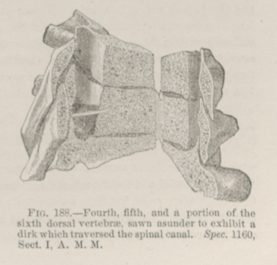Title: S——, George
Source text: Surgeon General Joseph K. Barnes, United States Army, The Medical and Surgical History of the War of the Rebellion. (1861–65.), Part 1, Volume 2 (Washington, D.C.: Government Printing Office, 1870), 425.
Civil War Washington ID: med.d1e18574
TEI/XML: med.d1e18574.xml
CASE.—Private George S——, Co. B, 15th New York Engineers, was admitted to Armory Square Hospital, Washington, on April 22d, 1863, having been stabbed with a knife in the back, at Falmouth, Virginia, on the 20th. He was completely paraplegic; the urine had to be drawn off by the catheter, and nothing but croton oil, in three-drop doses, succeeded in producing a passage three days after admission, two days after which, involuntary defecation and micturition set in. Sphacelus on all the projecting parts of the lower part of the body soon followed, proceeding rapidly until it nearly reached the spine of the sacrum. On May 10th, chills came on and recurred daily; death ensued on May 26th from exhaustion. The fourth, fifth, and a portion of the sixth dorsal vertebræ, sawn longitudinally to exhibit the blade of the knife, which appears to have been broken off at the time of injury and remains fixed in the specimen, are numbered 1160 of the Surgical Section, and were contributed to the Army Medical Museum by Assistant Surgeon C. C. Byrne, U. S. A. See adjoining wood-cut (FIG. 188).


